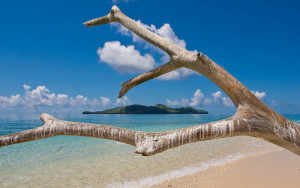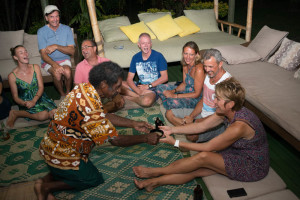.
Fiji
Culture
FIJI
consists of 18,376 square km of land and includes approximately 330 islands of which around 100 are inhabited. The largest island and population centre is Viti Levu, followed by Vanua Levu. It is located north of New Zealand and northwest of Australia. The four largest islands, Viti Levu, Vanua Levu, Taveuni and Kadavu are surronded by coral reefs and have mountains located in the central region of each island which cover a large portion of the land mass.
CLIMATE
Fiji has a tropical oceanic climate. The rainy season, from November to April coincides with the hot and humid months and the cooler months are from May to October. Humidity tends to be higher in the south and east and much less in the west and north. Tempertures in January in Suva can be min – max temp: 23 – 30 degrees C or 74-86 degrees F and in July: min – max temp:20-26 degrees C or 68-79 degrees F.
POPULATION
Fiji is perhaps the most cosmopolitan of all South Pacific nations. Its population just under 881,000 is a combination of indigenous Fijians (50%), Indians (46%), with the remainder of the population including Rotumans, Chinese, other Pacific Islanders and Europeans.
Indigenous Fijians have a culture and language that is fairly homogonous with hereditary chiefs and patrilineal descent. Indians first came to Fiji under British rule as indentured labourers over a century ago.
ECONOMY
Fiji’s economy is based on mainly agriculture and tourism. The sugar and tourism industries provide employment to over 50% of the labour force with that figure looking to increase due to the influx of resorts and hotels being built in the West. Both sugar and tourism are based in Western Viti Levu. A variety of crops are also produced including coconut oil, cocoa, ginger and kava.
Fiji’s tourism industry has grown over the last decade to become and important source of jobs and the major source of foreign exchange since 1990, surpassing sugar as an export industry at that time. Several new hotels and resorts being built in the Nadi and Sigatoka area will have a major impact on the number and frequency of people arriving in Fiji, as well as creating a large number of jobs.
HISTORY
Abel Tasman is credited with the first European discovery of the Fiji Islands in 1643. Captain James Cook passed through in 1774 and Captain William Bligh of the famous Mutiny on the Bounty tale navigated trhough in 1789. Further exploration was done over the next 30 years.
The Europeans that first arrived in Fiji include shipwrecked sailors, Australian escapees, traders, planters and of course the missionaries who arrived around 1830.
Throughout this time, Fijians were involved in internal wars. The leader of one of the two powerful groups, Cakobau became a Christian in 1854 and was named Paramount Chief of Fiji. Cakobau eventually made an offer to cede Fiji to Britain and the Deed of Cession was signed at Levuka, then the capital on October 10, 1874. The first group of indentured labourers arrived from India to work on the sugar cane plantations around this time in 1879.
Fiji attained independence from Britain on October 10, 1970 with the Queen as the Head of State.
FIJI CULTURE
The inhabitants of modern Fiji are of indigenous Fijian background, as well as of Indian, Chinese and European ancestry. Indigenous culture has shaped the nation and is an active and living part of everyday life for the majority of the happy folk that live here. The unique blend of cultures can be seen throughout Fiji, and in virtually every aspect of your stay – from the food, festivals, rituals and the arts.
The Fijians are pretty easy-going, but if you are invited into a village, wear modest clothing and take off your hat (wearing one is an insult to the chief) when in the village. Leave your shoes outside the door when entering a home and keep in mind that it’s also insulting to touch someone’s head – which can be tempting when you are surrounded by wide-eyed, smiling children.
When visiting a village, it is customary to present a gift of Kava, which is also known as “yaqona”. The gift, (a “sevusevu”), will cost approx. F$30 for a half kilo. If you are accompanied by a guide, he/she will look after that. The sevusevu is presented to the traditional head of the village (“Turaga Ni koro”). After it’s been pounded into powder and mixed with water, it is usually served in the head person’s house. If you are invited to drink Kava, don’t ask, just enjoy the ritual and the numb tongue.
Fijians are the friendliest people in the world. Your respect for their customs and traditions will not only make you a welcome guest in their villages and homes, but add another dimension to your Fijian holiday. For the lovo, meke and yaqona (kava) cermonies.
FIJI LOVO
This is a magnificent feast, cooked in the earth. It’s like a barbecue, only a little more smoked, and a very efficient way to cook large quantities of food at the same time. Lovo traditionally will consist of cassava (tapioca), kumala (sweet potato), yam, taro and various fish, meat and chicken, whilst a more modern Lovo feast will have many additional components.
KAVA/YAQONA CEREMONY
Yaqona (pronounced yangona) is Fiji’s national drink. It’s made from the pulverized root of a member of the pepper family. It’s believed to have medicinal qualities (apart from making you feel mellow). Legend has it that the ceremony came from Tonga where the plant sprang from the grave of a Tongan princess who died of a broken heart. In a formal yaqona ceremony authority is given by the village spokesman to begin mixing the Kava. When mixed, a server will carry a cup (‘bilo’) to the chief guest, who must clap (‘cobo’) once before and after completely drinking the first cup. The order of serving depends on the status of those present, from the highest-ranking chief down. Drinking yaqona has proved to be a great social unifier – it’s hard to be angry with someone after sharing Kava – and it usually leads to relaxed chat not unlike that in a casual bar.
MEKE
Music is woven into the fabric of Fiji and the Meke embraces traditional song and dance to tell of legends, love stories, history and spirits of the islands. It can vary from a blood-curdling spear dance to a gentle and graceful fan dance. There are two groups in the make – the orchestra (Vakatara), who sit on the ground and sing or chant for the second group, the dancers (Matana). The instruments are percussion (hardwood gongs, bamboo tubes, beating sticks etc). For the Meke the performers wear garlands of flowers (Salusalu), the men wear full warrior costume and the women, in traditional clothes, glisten with scented coconut oil.
One of the greatest experiences culturally in Fiji is simply learning about the country and its amazing and friendly people, also recognized as one of the Happiest People of the World. Fijians are culturally Happy People and when treated with respect and learning about their lives it is quickly the most significant experience everybody coming to visit will have as a memory. Another amazing aspect is learning about village life and the society which is still extremely strong in Fiji with people growing up with Chiefs and in a social community completely different to us from the western world, but extremely well functioning and showing us many examples of what another life can be like – producing absolute happiness.
Come visit Fiji and experience its culture and people – Its well worth it !






